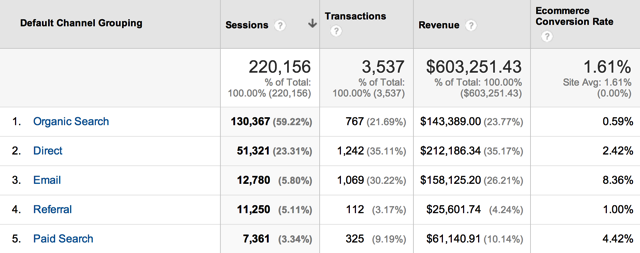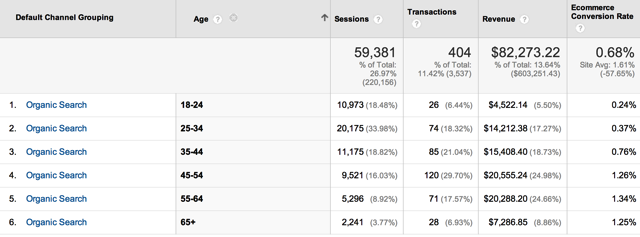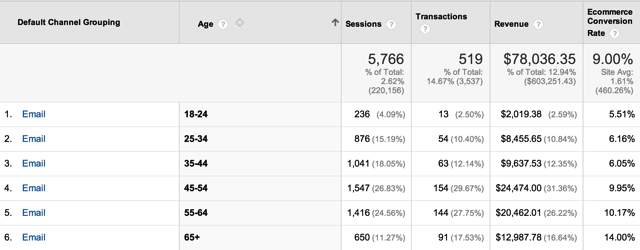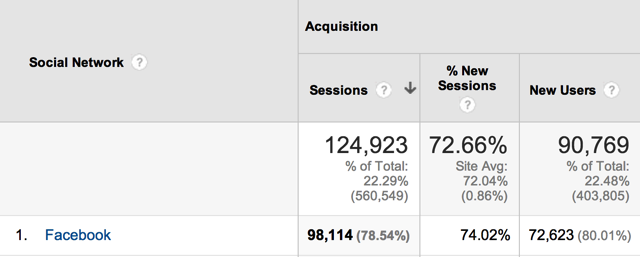We all know that Google Analytics is a powerful tool for diagnosing and understanding what happened on our website and by how much; that’s why websites like Online Behavior exist. What may not be clear is how to use this data we collect to find more customers.
For example, our reports in Google Analytics may tell us that Facebook is driving tons of conversions and revenue, but it is not easy to attribute that revenue back to an influential poster within their walled garden. Aside from reflecting on our own Facebook advertising efforts tagged with UTM variables, it’s difficult to use past traffic performance to predict future success.
The same goes for (not provided) organic keywords, many forms of social media and even remarketing. We can take credit for good things when they happen, but it’s not always apparent how we can find more of these good things in the future.
We could try to boil the ocean and advertise to all users of a social network trying to replicate our success, but that would be the equivalent of flushing our budgets down the toilet. Since we aren’t working the traditional media industry, I don’t think we could get away with that level of inefficiency.
How do we go about finding more customers if we can’t recreate the blueprint for our past success?
Segmentation
By my unofficial count, there are approximately a million ways to segment your users within Google Analytics. One of my favorite segments for predicting future success is looking at the demographics reports, because they allow us to look at the age range and gender of our customers to a great level of accuracy.
We can use this information to develop user personas and backstories and target by age/gender on advertising platforms. We can use this information to come closer to our goal of achieving a 1:1 audience with potential customers. Stacking demographic on top of our existing customer data allows us to turn the needle in a haystack into a haystack full of needles.
Where to get started? Here are some practical examples of how we can use the demographics reports in GA to find more of our best customers.
Demographics to improve organic search conversions
Let’s start with a report showing conversion revenue and conversion rates for an e-commerce store for the top 5 traffic sources. As you can see, the average e-commerce conversion rate of 1.61% is misleading, because there are no traffic sources that are even close to that conversion rate. Everything is either much higher or much lower, because as I like to say averages are lies.

By looking at conversion rates by channel grouping instead of the overall conversion rate for the site, we can draw many conclusions from this data. For example, we can conclude that Organic Search is under-performing compared to other traffic sources and that email marketing is a money making machine. But how do we improve upon something as vast as organic search conversion rate?
Start by digging deeper to see if a more clear answer emerges. Let’s look at the revenue spread by age. Are there certain age groups where organic search is performing better?

Note: since demographics data is not available for all users, the numbers below do not match the above perfectly. In this case, partial data does not change my approach to analysis. Also, I am using a custom report in order to get all into one screenshot.
When looking at the age of our organic searchers, are there segments of the population who jump out as being above average converters? Absolutely.
In this case it is quite clear that website visitors to the site who are 45+ years old will tend to purchase more often than their younger counterparts. Keep this in mind as you begin the optimization process.
What about gender? Do females and males see a difference in conversion rate and revenue?

Once again, the answer is yes. While organic visitors are 58% male, 72% of transactions and 67% of organic search revenue is coming from this population group. This segment is clearly doing much better than average and will likely deserve a greater share of attention.
Putting this into action
Now that we know our best organic search customer is a 45+ male, how do we act on this information? I would start by asking the following questions:
- How closely do our demographic conversion numbers match our ideal customer profile?
- Are our pages already appealing to the 45+ year old male?
- If yes, does that explain the high conversion rate?
- If no, should we adjust content to appeal even more?
- What type of imagery are we using on our pages to make users feel welcome?
- Would a 25-34 year old female find these images appealing?
- Is there an opportunity to appeal to our poorly performing segments on our top performing organic landing pages?
- Can we see enough revenue opportunity in Organic Search to make any necessary changes to our website?
By answering these questions honestly, we are able to determine where to make improvements to our programs. One improvement opportunity is appealing even more to the users that bring in the most revenue. Another opportunity is to try and bring up conversion rates for those who have not performed well traditionally. The best plan of action is likely to do a little of both.
Google Analytics is not telling us the answer to our problems outright, but mixing in demographics data is giving us the information we need in order to create a logical backstory for our visitors. From there we must take action to see improvement.
Demographics for email engagement
From our worst performing traffic channel above to our best, how can we improve upon an already successful email program? Let’s segment by demographics to see if there are any winners here, starting with age.

Look familiar? It should – the same customer age ranges are performing well in email that performed well in organic search. But what about by gender?

Once again, it is clear that the top performing customer segment is a 45+ male.
How do we take action?
I thought you would never ask! While often mystifying to search marketers, it should be known that email marketing is the ultimate delivery vehicle for segmented messages. Assuming that you have collected the birthday and gender of your customers, you should know exactly who is in your email database.
Using the demographic performance data above, it appears that the content within the emails that are being sent out appeal primarily to 45+ males. This is the largest segment of the email population, representing around 30-40% of the email database. While the emails may be working for this population segment, it means that over half of the database is receiving the wrong message!
Send them a different email
Sending a slightly different email to half of your database should not be too difficult. You can take your standard email and change the headline and imagery used within to appeal to a different segment. Before long you can start to measure the impact this has in improving conversion rates and revenue for your previously neglected customers.
By splitting your email list into two or more customer groups, you can see a huge increases in your overall email marketing revenue.
Demographics for targeted social media ad buys
Back to the topic of traffic and revenue coming from your website through social media. I opened this article by stating that you can use Google Analytics to understand the traffic driven to your site through Facebook, but supplemental information about these users is not always easy to come by. This is because Facebook referrals don’t provide a lot of useful information to our web analytics tools. They simply let us know that a visit happened.

But what about when we segment by age and gender? We start to see specialized areas for targeting users by age, gender and even interest categories.
What can we do with this information? Advertise to similar users! Social ad networks allow for a full range of targeting by age, gender and interest categories. We can use our past successes to buy ads on any number of social networks that may be of interest to our users. Instead of boiling the ocean to find more customers, we are making an educated guess as to who our next wave of customers will be.
Where else can we use demographics?
Everywhere. Demographics can come in handy in just about any form of marketing you can imagine. Here are three additional ideas.
1. Demographics for internal promotions
For companies engaged with email marketing and CRM, you can use the demographics of your logged in users to show them targeted internal promotions. If there are certain products or landing pages that appeal better to their population segment – use dynamic internal promotions to get them there faster!
2. Demographics for paid search improvements
Understanding the demographics of your paid search visitors can help you make landing page improvements, adjust your keyword list and reduce spend to inefficient ad groups and keywords.
3. Demographics for remarketing
The categories you see in the GA demographics reports align perfectly with those in Google Remarketing tools because… surprise! They are both Google products. Use remarketing on only those visitors who have the most conversion potential.
Closing Thoughts
The possibilities are limitless when it comes to demographics, because age and gender can be used to personify our ideal customers. Once we start to imagine our potential customers as real people instead of numbers, we can provide them with a better buying experience.
Now it’s your turn. Who are you going to target next based on demographics? I would love to hear your ideas in the comments section.








